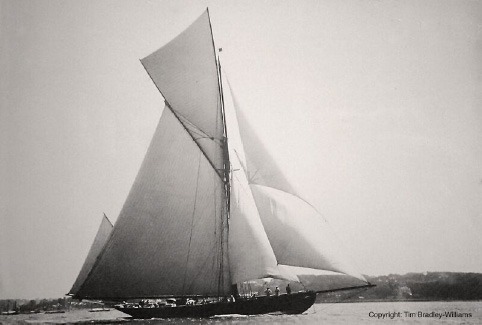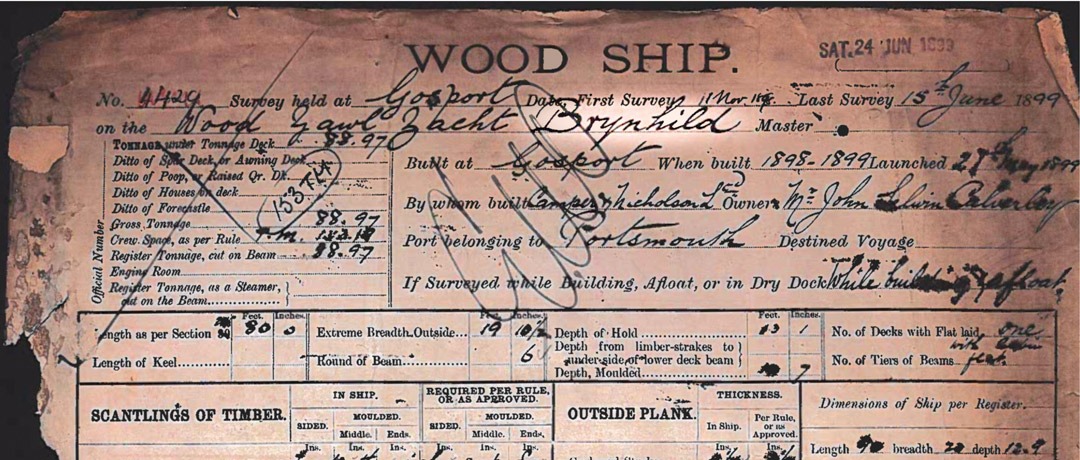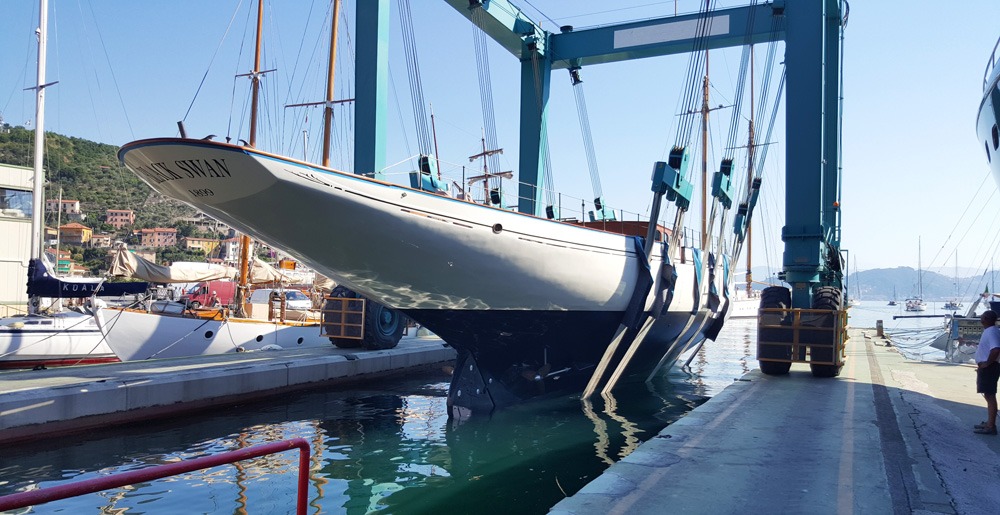History of the yacht
A history studded with victories and races
1899 – 2024
Pre-war period
Brynhild was commissioned by Major Selwin Calverey, a military officer and judge.
This sailing enthusiast took part in the 1900 Le Havre Olympic Games and finished second in the over 20-tonne category.
The horned yawl designed by Charles Ernest Nicholsons was launched at the Camper & Nicholsons yard in Gosport, England, in 1899. Calverey died a few months later.
In 1902, the new owner, Sir. James Pender, a British businessman and yachtsman, won the King’s Cup of Cows against Meteor III, organised by the prestigious Royal Yacht Sqadron on the Isle of Wight.
The prize was presented by Edward VII, King of the United Kingdom, Ireland and Emperor of India.

“Brynhild” pendant la course, Île de Wight
John Selwin Calverley au milieu de son équipage sur “Brynhil”
In 1907 Frédéric Schwann bought the boat, converted it into a ketch and christened it Swan.
Between 1912 and 1922, she competed successfully in Big Boat regattas, racing against the likes of Cariad, Valdora and Sumurun.
Between 1928 and 1936, Mr Foster became the owner and rechristened the boat Black Swan.
After the war
After sailing around the world in 1929, legend has it that BLACK SWAN was favoured by Mussolini in the 1930s. This would have saved her from destruction in order to recover her lead ballast for the manufacture of weapons during the war.
It was found in Italy in the 1980s, where it had a succession of owners. It was used as a support for a series of BBC reports in the Mediterranean.
Her last Italian owner offered her a complete restoration entrusted to Faggioni Yacht Design Studio, which was completed in 2002 with a ketch configuration. The owner, a former Forza Italia MP convicted of collusion with the Mafia, fled to Dubai to escape a five-year prison sentence. BLACK SWAN was seized and abandoned for several years at a shipyard in La Spezia.
It was a French shipowner who saved BLACK SWAN 1899 by buying her from the Italian banks.
It will take no less than three years of work to refurbish her, so that she can celebrate her 120th birthday by taking part in the Voiles de Saint Tropez in 2019.
Since then, this prestigious classic yacht, considered to be one of the oldest and most elegant still in operation today, has been based under the french flag in the Occitan port of Sète.
Launch of the Black Swan
Charles Ernest Nicholsons
1868 – 1954
 The son of Benjamin Nicholson, who had joined William Camper at the Gosport shipyard in 1842, Charles Ernest Nicholson not only inherited the family business, but also had a particularly good eye for yachts and a willingness to innovate.
The son of Benjamin Nicholson, who had joined William Camper at the Gosport shipyard in 1842, Charles Ernest Nicholson not only inherited the family business, but also had a particularly good eye for yachts and a willingness to innovate.
As a teenager, he was sent to France to learn French, as the shipyard had good customers there, but no technical training. At the age of 18, he started working with his father and older brother and built his first yacht, LUCIFER, a year later.
His DACIA, in 1892, was such a success that six weeks after its first sailing, it was sold for twice the price of its construction. This certainly launched his career as a yacht designer, and he went on to campaign for Lloyds to produce rules for yacht building. In 1906 he had the satisfaction of building NYRIA, the first large racing yacht built to Lloyds standards and, in 1912, ISTRIA a racing yacht which was the first yacht to have a Marconi topmast.
Its first attempt to take part in the America’s Cup was with SHAMROCK IV for Sir Thomas Lipton in 1914. The inter-war years marked NICHOLSON’s heyday with America’s Cup campaigns in 1930, 1934 and 1937 with SHAMROCK V, ENDEAVOUR and ENDEAVOUR II. During this period alone, he designed and built more than 200 yachts.
His last achievements were the ocean racing yacht.
His last designs were the ocean-going racing boat St BARBARA for the Royal Artillery YC, in 1948, and the cruiser ZOOM in 1952. He was the first yacht designer to be appointed Royal Designer for Industry in 1944 and was awarded the OBE in 1949. In 1997, he was posthumously inducted into the America’s Cup Hall of Fame.






